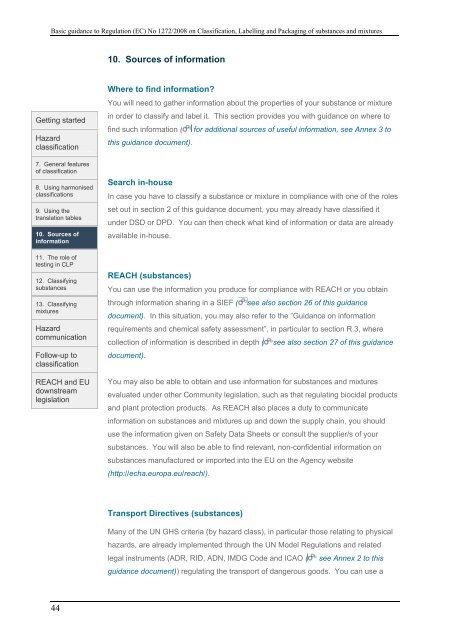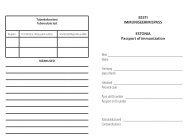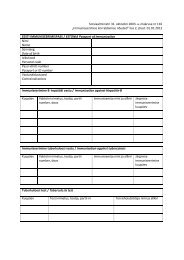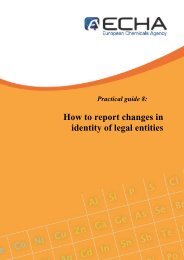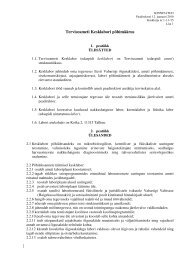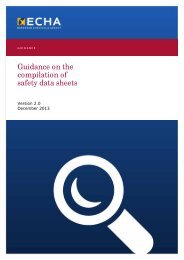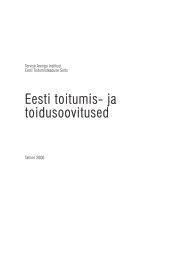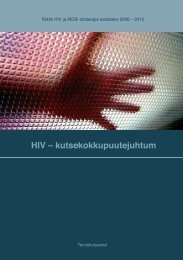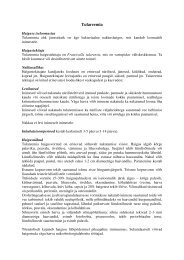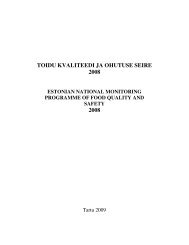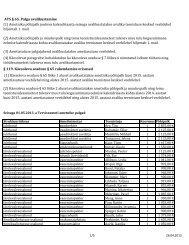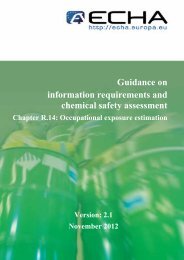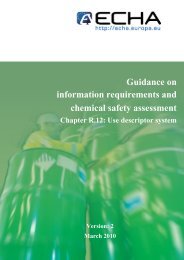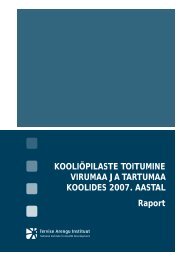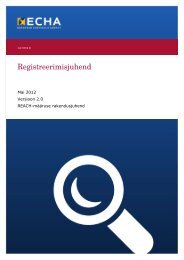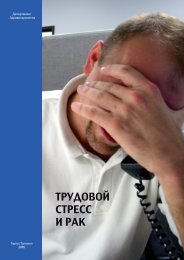Introductory Guidance on the CLP Regulation - ECHA - Europa
Introductory Guidance on the CLP Regulation - ECHA - Europa
Introductory Guidance on the CLP Regulation - ECHA - Europa
Create successful ePaper yourself
Turn your PDF publications into a flip-book with our unique Google optimized e-Paper software.
Basic guidance to Regulati<strong>on</strong> (EC) No 1272/2008 <strong>on</strong> Classificati<strong>on</strong>, Labelling and Packaging of substances and mixtures<br />
10. Sources of informati<strong>on</strong><br />
Getting started<br />
Hazard<br />
classificati<strong>on</strong><br />
7. General features<br />
of classificati<strong>on</strong><br />
8. Using harm<strong>on</strong>ised<br />
classificati<strong>on</strong>s<br />
9. Using <strong>the</strong><br />
translati<strong>on</strong> tables<br />
10. Sources of<br />
informati<strong>on</strong><br />
11. The role of<br />
testing in <strong>CLP</strong><br />
12. Classifying<br />
substances<br />
13. Classifying<br />
mixtures<br />
Hazard<br />
communicati<strong>on</strong><br />
Follow-up to<br />
classificati<strong>on</strong><br />
REACH and EU<br />
downstream<br />
legislati<strong>on</strong><br />
Where to find informati<strong>on</strong><br />
You will need to ga<strong>the</strong>r informati<strong>on</strong> about <strong>the</strong> properties of your substance or mixture<br />
in order to classify and label it. This secti<strong>on</strong> provides you with guidance <strong>on</strong> where to<br />
find such informati<strong>on</strong> ( for additi<strong>on</strong>al sources of useful informati<strong>on</strong>, see Annex 3 to<br />
this guidance document).<br />
Search in-house<br />
In case you have to classify a substance or mixture in compliance with <strong>on</strong>e of <strong>the</strong> roles<br />
set out in secti<strong>on</strong> 2 of this guidance document, you may already have classified it<br />
under DSD or DPD. You can <strong>the</strong>n check what kind of informati<strong>on</strong> or data are already<br />
available in-house.<br />
REACH (substances)<br />
You can use <strong>the</strong> informati<strong>on</strong> you produce for compliance with REACH or you obtain<br />
through informati<strong>on</strong> sharing in a SIEF ( see also secti<strong>on</strong> 26 of this guidance<br />
document). In this situati<strong>on</strong>, you may also refer to <strong>the</strong> ”<str<strong>on</strong>g>Guidance</str<strong>on</strong>g> <strong>on</strong> informati<strong>on</strong><br />
requirements and chemical safety assessment”, in particular to secti<strong>on</strong> R.3, where<br />
collecti<strong>on</strong> of informati<strong>on</strong> is described in depth ( see also secti<strong>on</strong> 27 of this guidance<br />
document).<br />
You may also be able to obtain and use informati<strong>on</strong> for substances and mixtures<br />
evaluated under o<strong>the</strong>r Community legislati<strong>on</strong>, such as that regulating biocidal products<br />
and plant protecti<strong>on</strong> products. As REACH also places a duty to communicate<br />
informati<strong>on</strong> <strong>on</strong> substances and mixtures up and down <strong>the</strong> supply chain, you should<br />
use <strong>the</strong> informati<strong>on</strong> given <strong>on</strong> Safety Data Sheets or c<strong>on</strong>sult <strong>the</strong> supplier/s of your<br />
substances. You will also be able to find relevant, n<strong>on</strong>-c<strong>on</strong>fidential informati<strong>on</strong> <strong>on</strong><br />
substances manufactured or imported into <strong>the</strong> EU <strong>on</strong> <strong>the</strong> Agency website<br />
(http://echa.europa.eu/reach/).<br />
Transport Directives (substances)<br />
Many of <strong>the</strong> UN GHS criteria (by hazard class), in particular those relating to physical<br />
hazards, are already implemented through <strong>the</strong> UN Model Regulati<strong>on</strong>s and related<br />
legal instruments (ADR, RID, ADN, IMDG Code and ICAO ( see Annex 2 to this<br />
guidance document)) regulating <strong>the</strong> transport of dangerous goods. You can use a<br />
44


